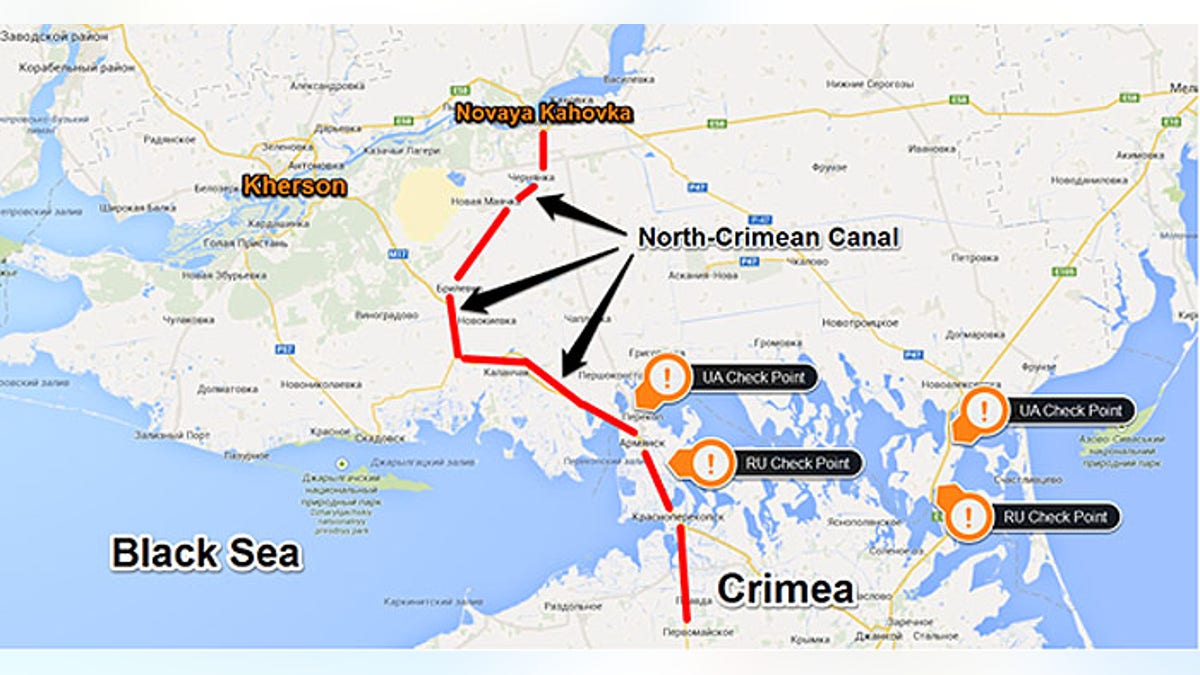
The Ukrainian peninsula province of Crimea is dependent on a 250-mile viaduct called the North Crimea Canal, for its freshwater. (Courtesy: Evgeniy Shpakovskiy)
As Russia’s stranglehold on Crimea tightens, the Ukrainian province to the north is warning it could make life on the peninsula miserable if the coveted region chooses sides with Moscow in Sunday's referendum.
Pro-Moscow officials in Crimea, who favor secession from Ukraine, have said they will seize all utilities and assets owned by the Kiev-based Ukrainian government if the referendum goes as expected. But Crimea's electricity, freshwater and natural gas all flows in from the province of Kherson, where leaders warn they will shut everything off if the referendum they say is illegitimate, goes forward.
[pullquote]
Last week, Kherson’s regional legislature overwhelmingly passed a motion supporting the preservation of Ukraine’s territorial integrity.
“We are doing everything in our power to keep the situation calm,” Kherson region governor Yuriy Odarchenko told FoxNews.com.
Last week, FoxNews.com reported on a tense standoff just north of the Kherson-Crimea border, where suspected Russian troops have set up a checkpoint along a key highway, just 25 miles south of a Ukrainian checkpoint. Locals in Chonhar, a small border village, say the Russians have planted land mines along the border.
But while most of the emphasis has been on preventing the Russians from moving into Kherson, Odarchenko indicated the province could go on the offensive if Crimea, which is 60 percent ethnic Russian, votes to secede.
Crimea's freshwater flows in from the Kakhov Reservoir in Kherson via the 250-mile North Crimean Aqueduct. The peninsula’s vast orchards and vineyards rely on mainland water supply for their livelihood, as do the people in Crimea’s cities of Simferopol, Sevastopol, Kerch, Sudak and Feodosia.
Just as important to Crimea is the power it gets from the Kakhov and Zaporizhiya hydroelectric power stations in Kherson, which provide the peninsula with 75-80 percent of its electricity needs. Finally, Crimea gets 35 percent of its natural gas delivered through pipelines that extend from the mainland via the Mykolayiv and Kherson regions.
Crimea’s chief gas supplier, Ukraine-owned Chornomornaftogaz, has already been targeted by the Kremlin-backed government that took power following the revolution in Kiev that ousted President Viktor Yanukovych last month. But even if they seize Ukrainian state-owned assets, including gas company Chronornaftogaz, it may prove moot if the raw resources are cut off in Kherson.
In the short term, Crimea cannot survive on its own without money from Kiev, according to observers. The peninsula gets $700 million from the national government each year, and Ukrainian economists have estimated that Crimea would need billions of dollars in new investments to integrate its economy and infrastructure with Russia.
While veiled threats emanate from the city of Kherson, the capital of the province of the same name, tension is high on the Crimea border. There are only two main roads leading into Crimea from the rest of Ukraine, one crossing the narrow Isthmus of Perekop in the west and another eastern route on the Azov Sea, known as the Kharkiv-Simferopol highway. Both are now patrolled by Russian and Ukrainian military units.
Ukraine’s State Security Service on March 12 said it had detected and detained a Russian military reconnaissance team dispatched to Kakhovka, Kherson region to assess Ukrainian troop strength near Kakhovka, south of Kherson.
“The group was monitoring the activities of the 3rd rocket artillery division in Kakhovka, the 208th rocket artillery brigade and the 79th motorized brigade,” the State Security Service spokeswoman said, adding its agents had confirmed that one of the men detained is a citizen of the Russian Federation from Ryazan, Russia working for Russian military intelligence.
DmytroTymchuk, who heads the center for Military and Political Studies and has been monitoring Russian troop movements, noted hat he called "a very disturbing picture" of Russian forces massing in the area of the narrow strip of land connecting Crimea to the mainland during the last 24 hours.
Tymchuk said at least 500 Russian soldiers from a battalion from Chechnya, Russia and up to 25 Russian artillery units, equipped with armored personal carriers and Russian Tiger fighting vehicles, are currently dug in at Perekop, south of Kherson province, with a corresponding number near deployed to Chonhar.
“The primary task of these units is to prevent Ukrainian troops from entering Crimea before the referendum on March 16. The military units may later be used to invade mainland strategic facilities in Kherson region,” Tymchuk said.
Ukraine's National Security and Defense Council head Andriy Parubiy said 80,000 Russian troops are deployed along the borders of Ukraine's eastern regions. The Russian armed contingent includes 270 tanks, 180 armored personnel carriers, 18 rocket launches, 18 fighter jets, 90 combat helicopters and up to 19 navy vessels.
Yuri Bochkovsky, head of the all-Ukrainian Border Guards Veterans Association, told FoxNews.com that Kiev has dispatched armored personnel carriers and airborne troops from Mykolaiv and Dnipropetrovsk regions to checkpoints along the highway on the western route, at Chaplinka and Kalanchak a south of Kherson, as well as in eastern Kherson region at Chonhar, along the Kharkiv-Simferopol highway.
“I think we have enough armor on the ground now to repel any Russian advance,” Bochkovsky told FoxNews.com.
